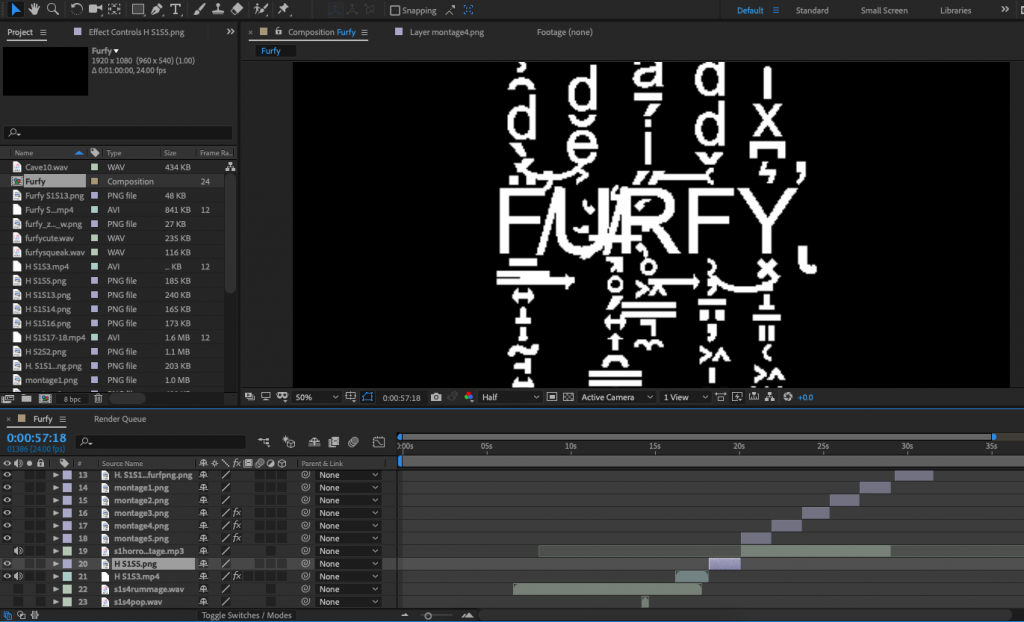Our Narrative 1 project challenged us to create stories and designs using visual and auditory elements. We learned how to use Illustrator to create designs (like the Design class has been doing all year), and turned those into physical products.
Learning how to use Illustrator is not limited to just Illustrator, but all vector graphics creation programs. Vector illustration is an important tool that one can use to create a variety of commercially-oriented art, and thus the skills can pay off in the long run. We also got more experience using Pro Tools, which translates to skills in audio editing, another important field.
Story
To start the Narrative unit, we did a character questionnaire and plot map in English class. The character questionnaire was to flesh out ideas for our main character in our story, and the plot map to plan out the plot. The inspiration for my story was from an earlier brainstorming exercise for something unrelated.
We made the audio version of our story by simply recording it, editing the audio to include music and sound effects, and generally cleaning it up in Pro Tools. Writing the story helped me with the style of writing that is necessary for doing a shorter style of story, and producing the audio increased my experience in Pro Tools.
Inspiration
It is mid-April in New York City. John Telsmann stares at a blank canvas in his apartment. He ponders ideas, scenes, pictures. Eventually, he takes a break for food. Things have not been going well lately. He last sold a painting a few months ago, and his savings from that and previous sales have been enough to tide him over until now. But he is currently starting to worry about his low finances. Is it possible I might have to get a real job?, he ponders. Doing such a thing would go against his entire spirit as an artist, to not express his opinions to the rest of the world, to not educate the masses, against their will if necessary. But it may be necessary to keep his current lifestyle. He has gone through hard times like this before, and has thought the same thoughts many times before. This time, however, things are a bit different. It’s not that things aren’t selling, it’s that he can’t come up with many good ideas. This, naturally, presents a significant issue.
On a dreary morning, as they tend to be at this time of year, John heads outside for his morning walk. He didn’t used to make a habit of exercise, but recently he decided to walk a new route each day, to try to get some inspiration. So far, it hasn’t been working. Today, he walks through the less affluent part of town. Beggars and panhandlers practically line the sidewalks. I wish I could help them, John thinks. In easier times, he would. Alleyways are everywhere, dark corners where the addicts and other unsavory folk spend their time. Today, just as John happens to be passing by, a stray cat wanders out of one of these alleys. John notices it, and it notices him. The cat meows, demanding attention and scritches. It has clearly been somebody’s pet before, but the state of its coat and its weight indicate it is not currently. John obliges, briefly, before continuing on his way. What he does not notice, however, is that the cat follows.
After an uneventful walk, John returns home to work. As he unlocks the outside door, he feels something fuzzy brush across his legs. “Cat,” he says, “why are you here? Don’t you have someplace better to be?” He is not unfamiliar with the feline mind, having had one as a child. The cat continues to demand attention. John sighs, but suddenly remembers that the landlord does allow pets. Perhaps it may be beneficial to take it in?
Three days later, John has gotten accustomed to having a cat around and can focus on work once more. He read in the paper this morning that there will be a big art auction in a few weeks, and realized that this is his opportunity. He needs to finish a painting before then, or he will have a much harder time selling one.
Days pass. Inspiration remains elusive. The cat has been named Fred, and has taken to knocking down tubes of paint from the counter. None of them have been open so far, but John wonders what would happen if one were. He knows paint would get everywhere, but what would it look like? He muses over this for a few minutes, and suddenly, he has an idea. He sets up a fresh canvas, takes his palette and brushes, squeezes out some paint, and gets to work.
Two weeks of hard work later, it is finished. The piece shows a cat, the form helpfully modelled by Fred, knocking down jars from a shelf, which land on the ground to create nothing other than the Earth. He entitles it “The Creation”. John breathes a sigh of relief. He has finished a painting before the auction, before needing to get a job. He wonders whether he could have done the same if it weren’t for Fred being a cat, and doing that which cats do best. No matter now. Now all that matters is the auction.
The big day arrives, not without a certain amount of unreasonable worrying that the painting will get lost (while sitting in the locked study) or damaged (while being thoroughly protected from Fred). John arrives at the auction house, checks in the painting, goes to the floor, and waits. After an hour of sales, at the expected prices, the auctioneer announces that the next piece will be “The Creation”, by John Telsmann. It is unveiled. The audience takes a moment to look it over, judge it. John is suddenly terrified. What if nobody bids on it, like that one painting earlier? He knows that that painting was just plain bad, but this does not stop the nerves. After a short silence, which feels much longer than it should, a bidder stands up. They offer a low amount, obviously to try to pick it up for cheap. John knows that this tactic never works, and is never attempted, unless the item in question is of low or medium quality. The nerves redouble, and another tense moment passes. The auctioneer begins to say, “Going once, going twice,” and John begins to panic quietly. But then another bidder stands up, and offers a much more reasonable amount, one that John would be happy with, and the nerves disappear.
Several more bids are made, getting to legitimately high prices, and the auctioneer announces the sale. The rest of the auction is a blur of patiently waiting. John picks up his cut of the sale, more than enough to keep going for almost a year without selling anything else. As he goes home, he feels that he succeeded as an artist, that he made a piece with a deep message, and made a point to the public. As he enters the door, Fred greets him with what John now knows to be the typical “Feed me, you idiot,” meowing. Today, Fred actually gets fed when he expects it, instead of the haphazard timing of the last few days, and John thanks him for his help. Fred does not understand, but John feels that this cat he found on the street one day will help him out in both tangible and intangible ways. Companionship, he finds, is important in life. In the future, Fred helps John, John sells more paintings, and his name is somewhat known. But for now, John rests, satisfied and overjoyed.
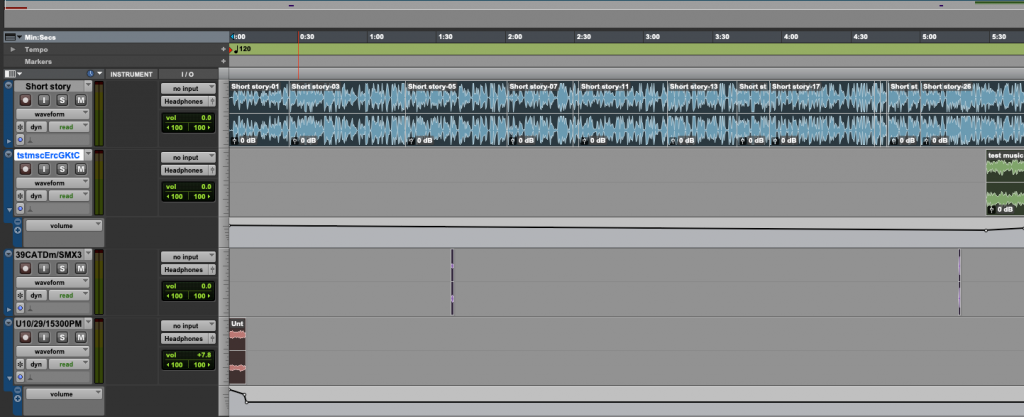
Illustrations
Geometric Light Cover
Our Geometric Light Covers were our final project of 2019. They are meant to hang down with a light inside of them, casting interesting shadows and looking pretty. We used Illustrator to design the designs that were laser-cut into sheets of plastic and assembled into the final product.

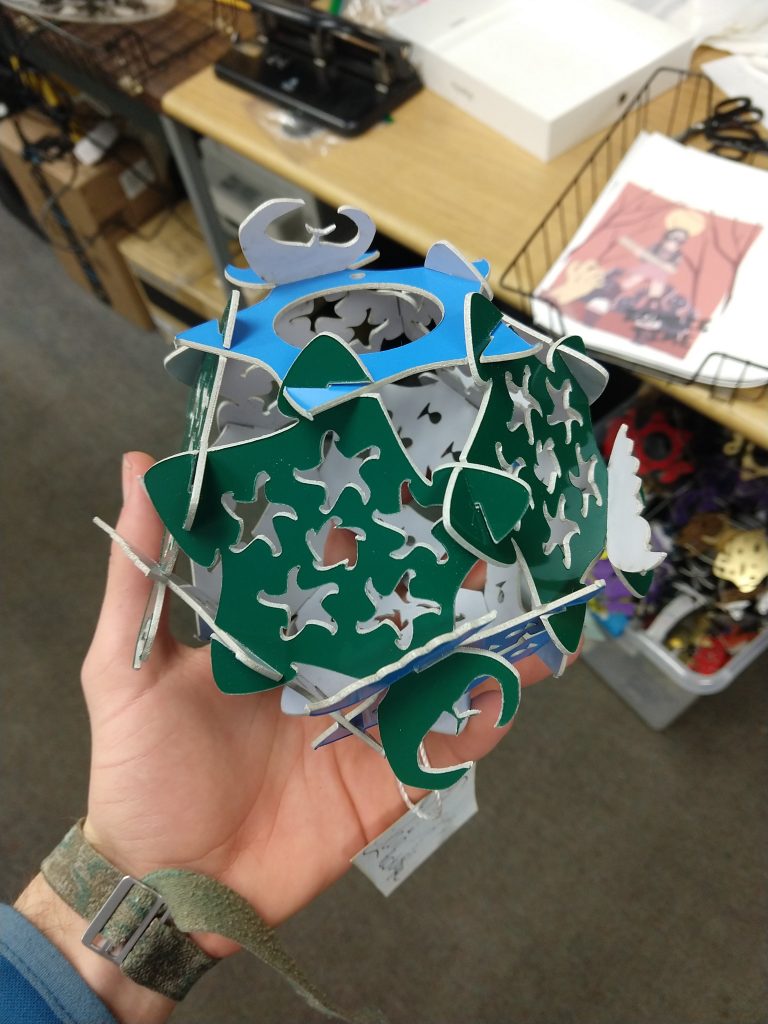
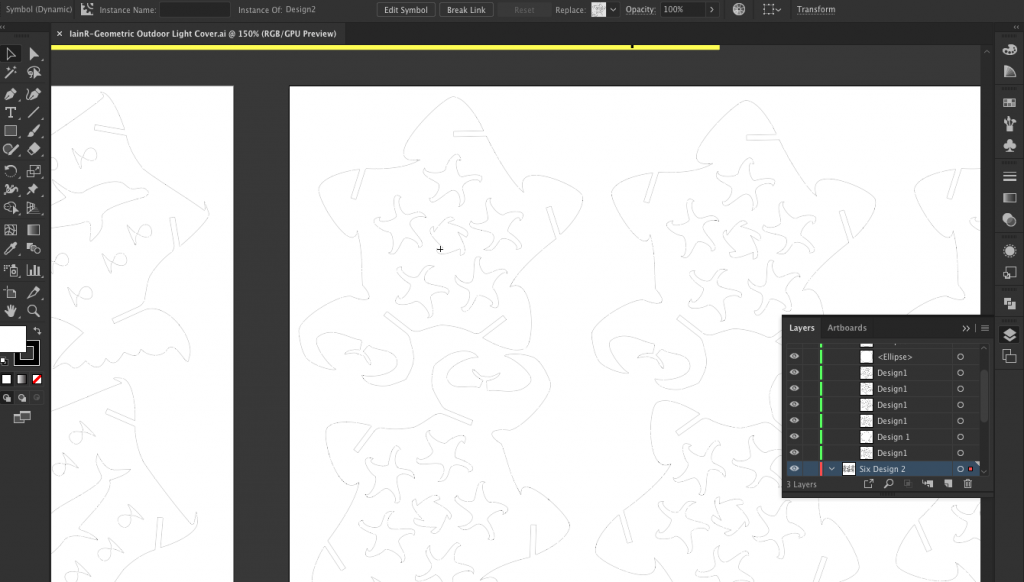
My geometric light cover is entitled “Preservation”. One of the great issues today, which has sadly (and terrifyingly) been overshadowed by other problems, is that of the oceans. They have been under harsher and harsher conditions than ever before in the past few decades, and their situation is primed to get worse. Acidification is running rampant, bringing along coral bleaching, which threatens to disturb the entire ocean ecosystem. As all things in life are interconnected, this means drastic impacts on land life as well. This is the reason I decided to do my geometric light cover on the topic of the oceans, and the title on one way to help them. The dolphin has always been one of my favorite animals, as they are incredibly smart and playful, living the life some of us dream of. They are also highly threatened by the recent changes in the oceans, so I decided to make one front and center in my design. The design also features waves, starfish, and other iconic oceanic designs.
I created the designs using Illustrator, making heavy use of the pen tool. All the lines had to be set to a width of 0.001 pixels and colored pure black, to make the laser cutter understand that it should only cut a single line, and not an area. This was the first major project I made using Illustrator, so I gained skills that I will need for future pieces.
Illustration Project Choice
For this project, we had a choice of various projects to design in Illustrator. I chose to make a design to engrave on my phone.
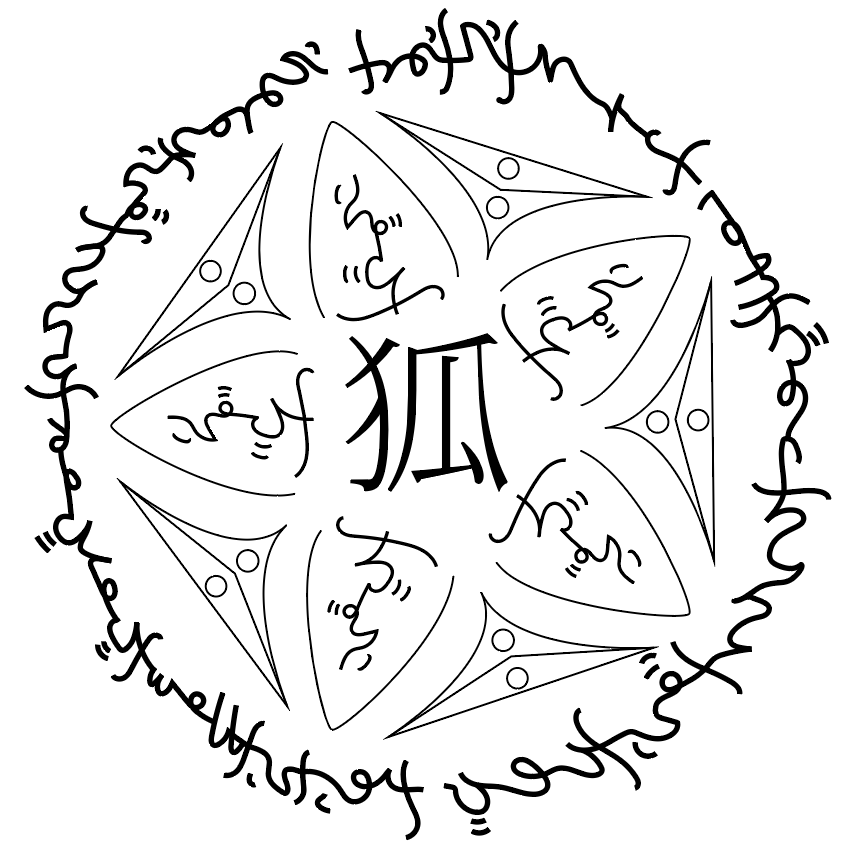


The first thing that one would notice about my Illustrator project is that most of it seems to be in a strange, foreign language. This is, in fact, the case. The language in question is a conlang (constructed language) called Sekir. Along these lines, my choice of title for this piece is “Sekir musings”. I chose the phrases along the outer edge because they have personal significance, and represent a part of myself and my personality. Since mystery is a great part of art, I will only transcribe the phrases, and not translate them. If the reader wishes to understand, they can spend time learning a new language, which is an extremely rewarding activity. They read, “Qu ī het kral maut sisk a’ī saum” and “Qu ī lar maqmad sisk a’ī saqauī”. The word repeating around the design transcribes as “ma’ī”, and means “soul”. I felt this was an important enough term to be repeated multiple times, as the soul is arguably the most important part of a person, their essence. The character in the center is the Japanese kanji for Kitsune, which, to me, represents the necessary hope for magic in the world and an escape from the stifling confines of relentless humanity.
I used Illustrator to create this project. This project was designed to be engraved onto a mobile device. I used the pencil tool for the Sekir writing, as it performs better than the brush tool in most situations. The calligraphy in the center was made by using the text tool, and the rest was made with the pen tool. I used repeating transform effects on groups to copy the repeating designs into a circular pattern.
Animation
In Animation, we started off the unit by making sets for our Mood Scene animation, which is a combination of digitally-drawn and puppet stop motion animations, walking across a physical background. The set was created in groups of 3, and I worked on it with Nick N and Nick S. The stop-motion animation was difficult to make look good, as we had to create the puppets ourselves, and I am not exactly the best sculptor. The digital animation was much easier to do, aside from taking much longer. After this project, I decided to switch to using Krita instead of Photoshop, since the animation interface in Photoshop is difficult to work with, and I feel Krita is better for illustration. It also doesn’t hurt that Krita can (partially) read and write to .psd files.
Also, the start of this project was when Mr. Cho joined the Freestyle team, and he has been doing a wonderful job!
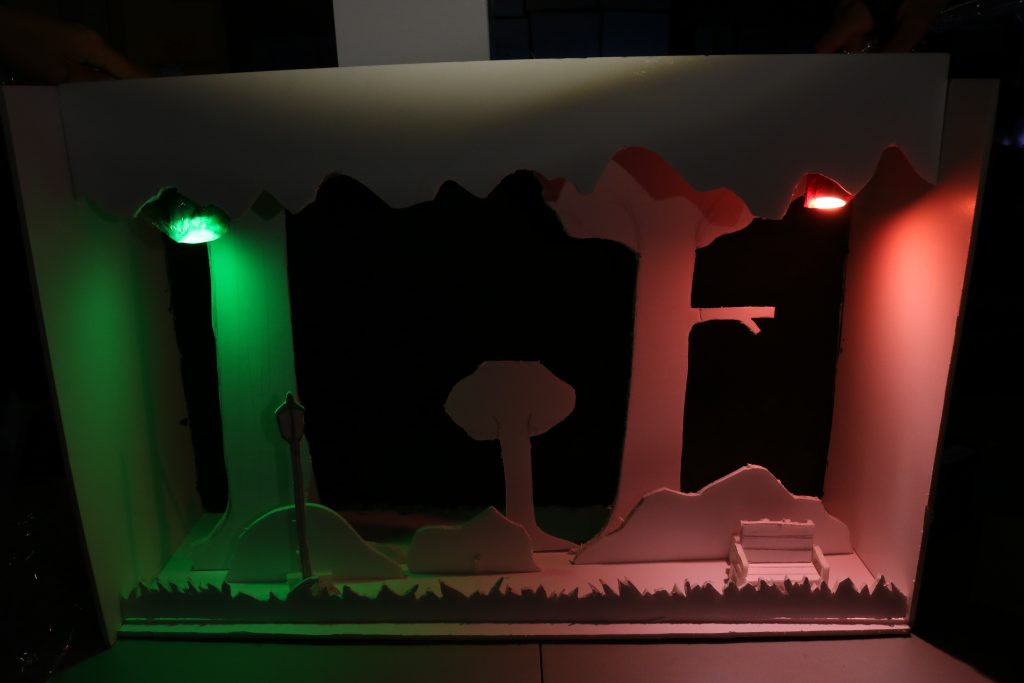
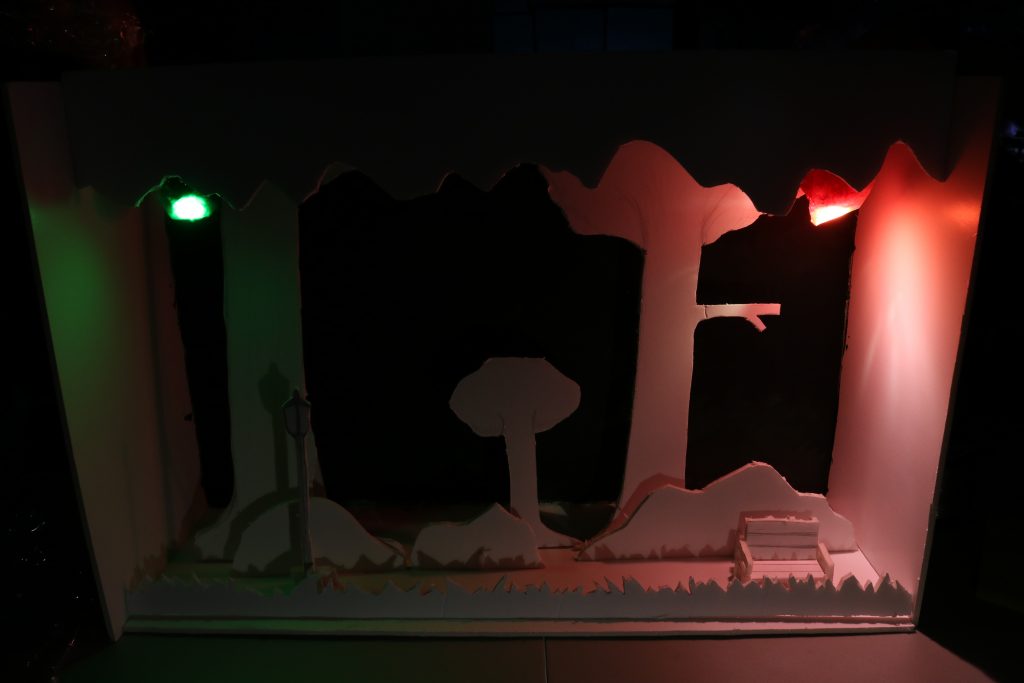
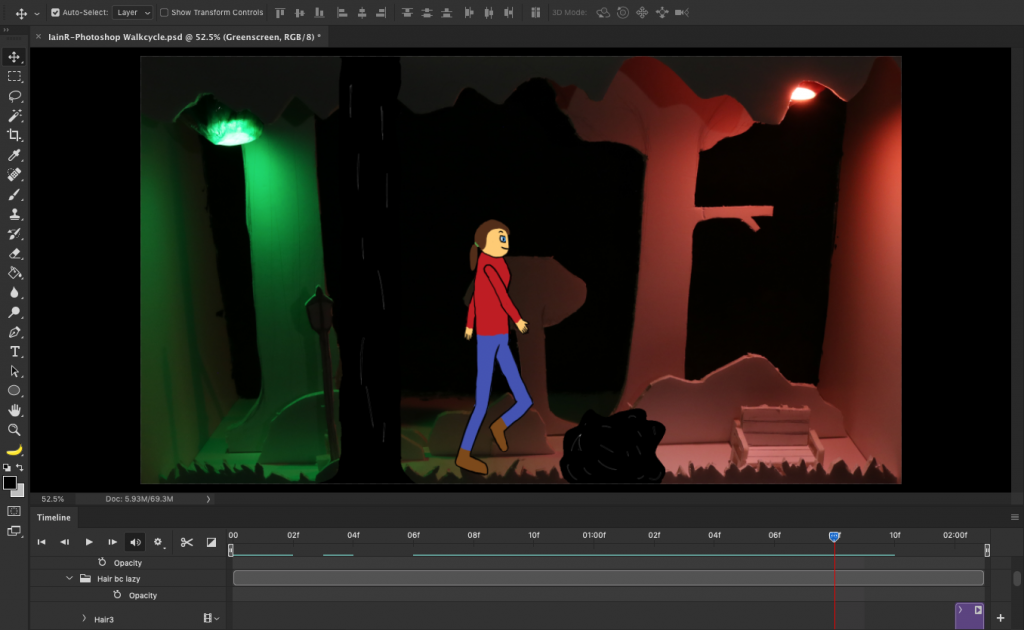
Yes, that is a banana.
We also made a character bio for the character we used for our puppets, featuring a digital design and a picture of the actual puppet. I decided to not use the same character for the digital portion of the animation.

Our next production for the project was the visual narrative, where we got into groups of 3, created a story, and did 40-60 seconds of animation. I worked with Alec C and Andrew H on this project, which I feel explains itself, as a Furby horror-ish style of animation. We used Photoshop (and Krita) to create the animation and backgrounds, and put it all together using After Effects.

